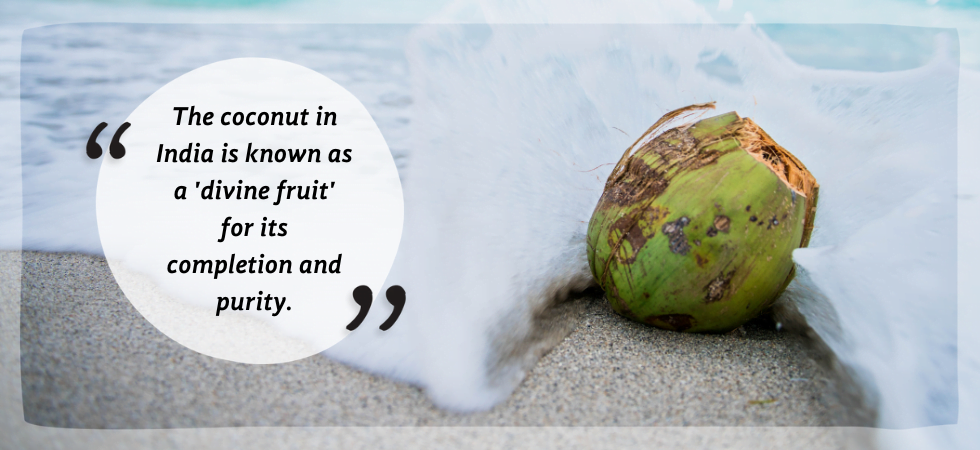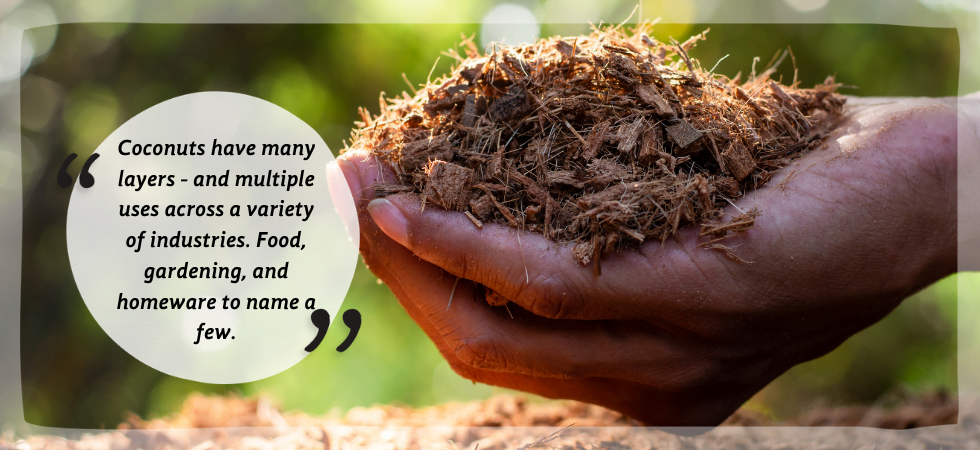The Anatomy of a Coconut
You may have taken a look at the title of this blog and started thinking, “Hey Coco & Coir, why do we need to know about what a coconut really is anyway?” To that we’d have to say, well, there’s no better way to understand where your compost comes from than to fully understand all the ingredients that are used within it. Our composts are 100% natural coconut coir, and once you learn what that actually is and just how exceptional the coconut is not only in our foods but in our gardens, you’ll really get to know the intricacies of your plants’ foundations built on our helpful compost.

The Cultural Significance of the Coconut
Believe it or not, the coconut itself is not regarded as simply a fruit in many cultures around the world. In India, where our coir is lovingly grown and prepared, the coconut is seen as a divine fruit. This is because the fruit does not grow from any singular part that is thrown away. To grow a coconut tree, the entire fruit – husk and all! – must be planted. The plant (known by its scientific name cocos nucifera) cannot grow from what remains of the fruit or from that which is eaten by other animals. As such, it is an entirely ‘whole’ fruit, and its completion and purity is what makes it divine.

So while many may see the coconut as just another tropical favourite, there are many cultures out there that hold it to very high standards. For good reason too, we think. Our motto isn’t ‘everything in a nutshell’ for nothing!
Recycle and Upcycle
No matter how we look at the coconut, there is no denying that the most popular of uses for it is in the food industry. Coconut water, milk, and meat (or the ‘kernel’ as it is sometimes called) are staples in many recipes, and are very well known. When the coconut is mentioned, food is the first thing that comes to mind for most people too. That is why it comes as a surprise to many that the ‘waste’ product from the coconut does in fact make some fantastic products when turned into something useful!
Coir compost is just one example of what would be deemed waste turned into something of use. Coir can also be made into rope and other fibres, used in carpets and even in doormats – just like the ones we make! Don’t worry about the shells being thrown away too, they’re not just useful for those school plays where you need the clip-clop of a horse’s hooves. The shells can be turned into a type of charcoal after being ground down and burned, creating a sustainable charcoal that is quick to light and low on odour. Quite the unexpected item to come from coconut waste, right?
According to MadeHow, there is also “an alternative to plywood that is made by impregnating a coir mat with … resin” being developed too, giving an alternative to wood-based flooring (which in some instances is not as sustainable of a resource as coconut fibre). It just shows how versatile the coconut truly is, and we cannot wait to see what else others in the industry discover coconut’s uses for. The versatility is near endless.
A coconut is much more than just something we eat. It provides many industries with livelihoods and ways to stop materials going to landfill sites. The more waste we can turn into useful products, the more opportunities we can find to keep our lands and oceans clean, environment protected, and households supplied with sustainable products to replace those made irresponsibly.
Is It A Fruit? Is It A Nut? Is It A Plane?!
No, you’d be surprised to know that coconuts are in fact not a nut. They are masters of deception! A little bit like the secret spies of the fruit and nut world. Coconuts are what we call a drupe – members of a family of ‘tree nuts’. Drupes can be identified as “a fruit with a hard stony covering enclosing the seed.” See The Library of Congress guide for more of the technical aspects if you’re feeling curious!
Let’s go over the basics.
A Look Inside the Coconut

Many of us are all too familiar with what a coconut looks like, but we want to show you a step further than those toony drawings you see on the side of your smoothie bottles. Oh yes, dear coir-loving readers – we’re taking a true deep dive into the coconut. This helpful guide will tell you all you need to know about this well-loved sweet treat and source of many wonderful gardening products!
- Outer Fruit Skin
The green skin shown to be surrounding the coconut. Known as the ‘exocarp’. Protects all the goodness kept inside and has a beautiful colour. Many often forget that this is what the coconut looks like prior to shucking! - Husk
Also known as the ‘mesocarp’. This is where our coir comes from. It sits below the outer fruit skin and protects the fruit inside. The husk itself has a fibrous texture, - Shell
The exterior of the coconut, also known as the ‘endocarp’. Not just for horse-hoof sounds at school plays! This protects the delicate fruit interior and is useful for natural bird feeders, charcoal, and much more. - Fruit
Delicious and perfect for cakes, the fruit is the most commonly used part of the coconut. For good reason, too – it’s full of natural fats and calories, giving a good alternative to more sugary snacks for fans of sweets. - Water
Keeping you hydrated on those warm, tropical beaches – and (not so warm or tropical) balcony gardens in the UK! It is commonly used in recipes, but also for treating common medical ailments like dehydration thanks to an abundance of natural electrolytes.
A coconut, as you can see, has many layers. (Not dissimilar to ogres, right? Kudos if you get the quote!) They are one of the most versatile natural resources we have, and they are one that we at Coco & Coir love to spread the word about. The more people know just how incredible a coconut is and that it is more than just those dried white sprinkles in a cake, the better!
Creating Composts from Coconuts
Now that you know what a coconut is made up from, you must be wondering just how we manage to turn something that is far removed from soil into a working compost. Our coir is created by finely grinding down the husk of the coconut, creating a soft-textured compost that closely resembles natural soil. After it is ground down, it is compacted into the solid bricks you see for sale. Just add a little water once more, and the compost is back to being its usable, fluffier self.
Thanks to the texture of coir being so similar to natural soil and sphagnum moss / peat, it makes it a fantastic medium for plants’ roots to be able to take shape in. Coir is naturally able to retain up to 10 times its weight in water, making it perfect for keeping your plants’ roots from drying out too quickly. It is the fibrous texture that allows it to retain the moisture so well, though be careful – if the coir retains too much water, your plants may be over-saturated!

Compost, Mulch, and More!
Let’s not forget the other uses of the coconut husk! The husk can be turned into three key products: coir pith (what our coir is), fibres, and coconut chips. The main uses for each are varied.
While the pith is great as a growing medium for supporting growth of seedlings, plants, and other crops, the larger pieces of husk – sold as ‘chips’ – are better suited for other purposes. Many gardeners use these as a mulch or to add decorative borders to garden beds and pathways. We also make our own with our Coco Chip coir mulch – why not take a peek and see what it could do for your own gardens?
All Wrapped Up In a Nutshell
That’s a wrap on our deep dive into the anatomy of a coconut and what it can do. We hope that you are just as impressed by all that it can do for your lifestyle as we are. If you are looking for some wonderful new alternatives to other products to add to your life in an eco-friendly journey, look no further than the coconut. Divine, versatile, and our favourite crop.
If you have been investigating uses of coir and coconuts, why not tag us in your photos of our products over on Instagram? We’d love to see your progress using coir for your home improvements and garden!










